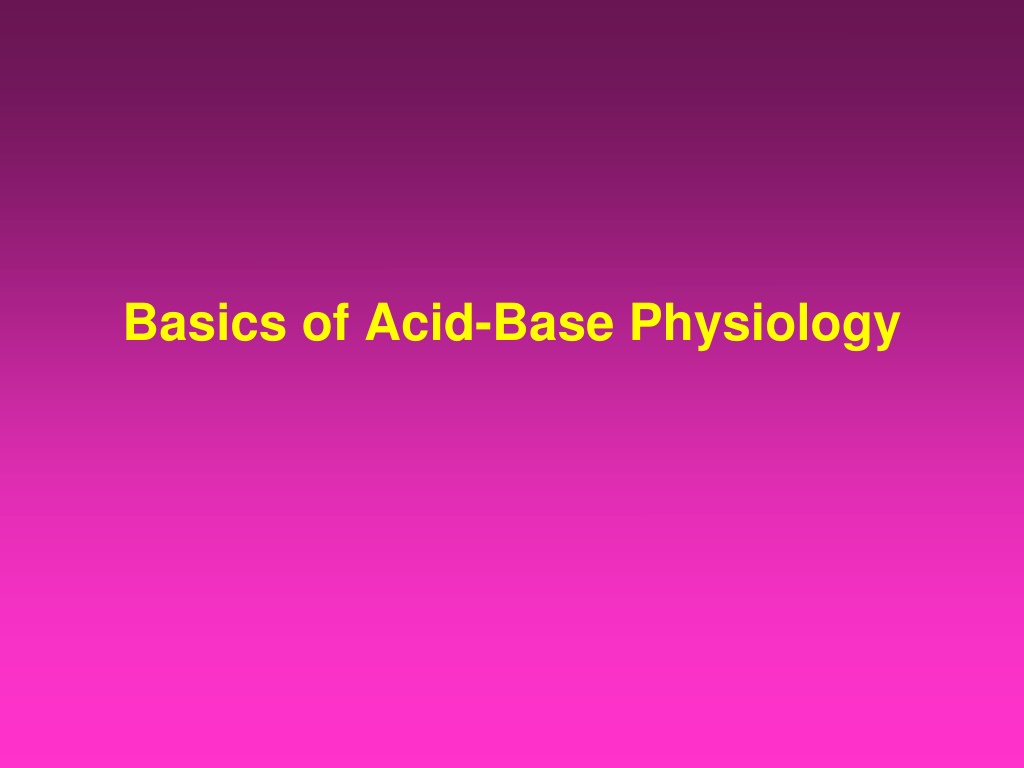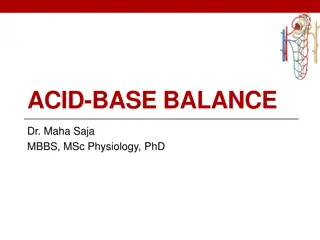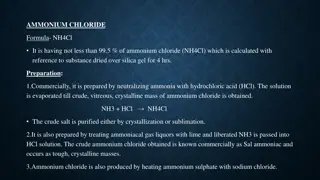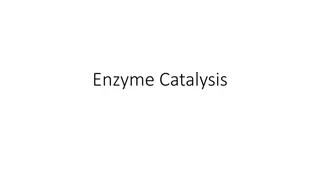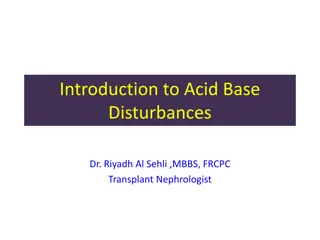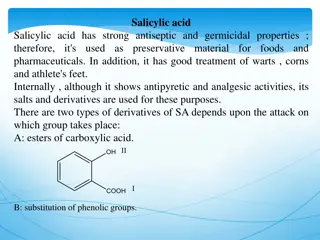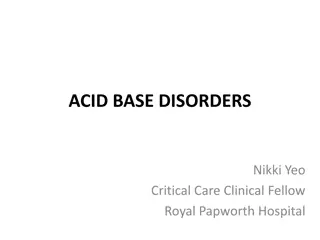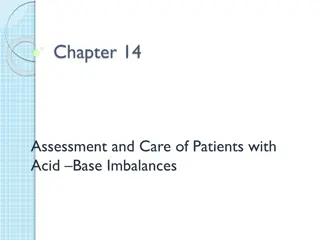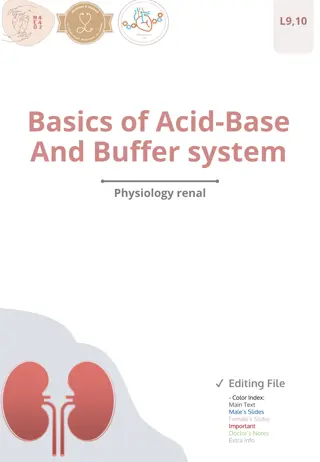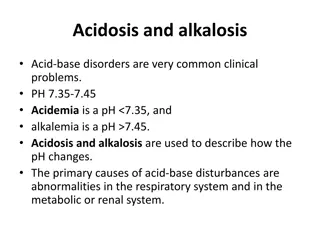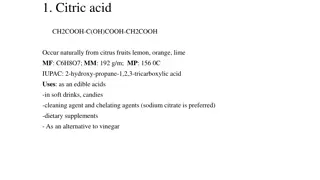Understanding Acid-Base Physiology in the Human Body
Acid-Base homeostasis plays a crucial role in maintaining the optimal acidity of body fluids through a balance of chemical buffers and physiological processes. Disruptions in this balance can lead to various effects on the central nervous system and ionized calcium levels. Understanding the concepts of acid-base balance, ionized calcium concentration, and the definitions of acids and bases is essential for comprehending the intricate mechanisms regulating pH levels in the body.
Download Presentation

Please find below an Image/Link to download the presentation.
The content on the website is provided AS IS for your information and personal use only. It may not be sold, licensed, or shared on other websites without obtaining consent from the author. Download presentation by click this link. If you encounter any issues during the download, it is possible that the publisher has removed the file from their server.
E N D
Presentation Transcript
Acid-Base homeostasis involves chemical and physiologic processes responsible for the maintenance of the acidity of body fluids at levels that allow optimal function of the whole body. 2 2
ACID BASE HOMEOSTASIS The chemical processes represent the first line of defense to an acid or base load and include the extracellular and intracellular buffers. The physiologic processes modulate acid-base composition by changes in cellular metabolism and by adaptive responses in the excretion of volatile acids by the lungs and fixed acids by the kidneys. 3 3
Effects of PH on CNS PH decrease ( acidosis) depresses the central nervous system. Can lead to loss of consciousness Ionized Ca++ concentration (Hypercalcemia) PH increase ( alkalosis) can cause over-excitability Tingling sensations, nervousness, muscle twitches Ionized Ca++ concentration (Hypocalcemia) 4 4
Acid-base abnormalities alter the ionized Ca++ con. by changing the fraction of Ca++ bound to plasma albumin. Albumin has negatively charged sites, which can bind either H+ ions or Ca++ ions. Acidosis Alkalosis H+H+ H+ Ca++ Ca++ H+Ca++ Ca++ Ca++ Ca++ Albumin Albumin Ionized [ Ca++] ionized [Ca++] Hyperventilation Respiratory alkalosis ionized Ca++ Tetany.
Acid - Base balance is primarily concerned with two ions: Hydrogen (H+) Bicarbonate (HCO3- ) 6 6
H+ ion has special significance because of the narrow ranges that it must be maintained in order to be compatible with life. 7 7
Acids can be defined as: - A proton (H+) donor - Hydrogen containing substances which dissociate in solution to release H+ Bases can be defined as: - A proton (H+) acceptor - Molecules capable of accepting a hydrogen ion (OH-) 8
Strong Acid An acid that nearly completely dissociates All molecules of the acid break up to form the ions soluble in water
Weak Acid An acid that only slightly dissociates in a water solution Only a small percent of acid molecules donate their hydrogen, and most remain the same.
Physiologically important acids include: - Carbonic acid (H2CO3) - Phosphoric acid (H3PO4) - Pyruvic acid (C3H4O3) - Lactic acid (C3H6O3) These acids are dissolved in body fluid Physiologically important bases include: - Bicarbonate (HCO3- ) - Biphosphate (HPO4-2 ) 11
EQUATION OF ACID-BASE PHYSIOLOGY The hydrogen ion concentration [H+] in extracellular fluid is determined by the balance between the partial pressure of carbon dioxide (PCO2) and the concentration of bicarbonate [HCO3-] in the fluid. This relationship is expressed as follows: [H+] in nmol/L = 24 x (PCO2 / [HCO3 -] )
NORMAL VALUES Using a normal arterial PCO2 of 40 mm Hg and a normal serum [HCO3- ] concentration of 24mEq/L, the normal [H+] in arterial blood is: 24 (40/24) = 40 nmol/L
Acid-base Balance Henderson-Hasselbalch Equation [HCO3-] pH = pK + log ---------------- .03 [PaCO2] For teaching purposes, the H-H equation can be shortened to its basic relationships: HCO3- pH ~ --------- PaCO2 14
Normal Range pH = 7.35 - 7.45 PCO2 = 35-45 mmHg (40 mmHg) HCO3- = 22-26 mEq/L (24 mEq/L)
pH is inversely related to [H+]; a pH change of 1.00 represents a 10-fold change in [H+] pH 7.00 7.10 7.30 7.40 7.52 7.70 8.00 [H+] in nanomoles/L 100 80 50 40 30 20 10
SOURCES OF HYDROGEN IONS 1) Cell Metabolism (CO2) 2) Food Products 3) Medications 4) Metabolic Intermediate by-products 5) Some Disease processes 18 18
SOURCES OF HYDROGEN IONS 1) Cellular Metabolism of carbohydrates release CO2 as a waste product Aerobic respiration C6H12O6 CO2 + H2O + Energy 2) Food products Yogurt Citric acid in fruits 3) Medications May stimulate HCl production by parietal cells of the stomach. 19 19
SOURCES OF HYDROGEN IONS 4) Metabolic Intermediate by-products Lactic acid Pyruvic acid Acetoacetic acid Fatty acids 5) Some disease processes Ex: diabetes causes improper metabolism of fats which results in the generation of a waste product called a Keto Acids. 20
Normal Arterial Blood Gas Values* pH PaCO2 PaO2 SaO2 HCO3 %MetHb %COHb CaO2 7.35 - 7.45 35 - 45 mm Hg 70 - 100 mm Hg ** 93 - 98% 22 - 26 mEq/L < 2.0% < 3.0% 16 - 22 ml O2/dl * At sea level, breathing ambient air ** Age-dependent
